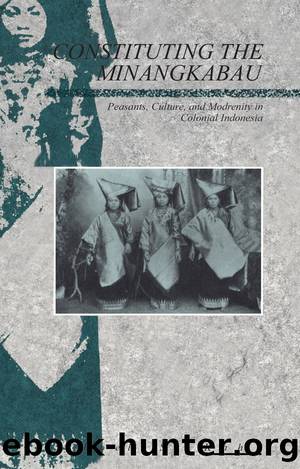Constituting the Minangkabau by Joel Kahn

Author:Joel Kahn [Kahn, Joel]
Language: eng
Format: epub
ISBN: 9780367716868
Barnesnoble:
Publisher: Taylor & Francis
Published: 2021-03-31T00:00:00+00:00
Clan and Village in the Minangkabau Highlands: 1800â1870
As we have seen, the images of Minangkabau constructed in the first few decades of this century are focused largely on either forms of suku organization or on basic territorial units known as nagari. If, as assumed by most of our observers, Dutch and Indonesian, these institutions were eroded by changes association with the liberal colonial reforms after 1870, then what was their role in the earlier part of the nineteenth century?
In much of the literature on the Minangkabau, we are presented with an image of a society in which the village community or nagari is the basic unit of social and political organization. This has led some writers to speak of nagari as âvillage republics.â Even more so than today, Minangkabau people in the nineteenth century belonged almost exclusively to individual nagari communities. As late as 1905, for example, at the time of our first vaguely reliable census, the total population of Sumatraâs West-coast was reckoned to be just over 1.3 million people, while the population of Padang, the capital, stood at just over 90,000. Apart from Padang there were no towns in the Government of Sumatraâs Westcoast of more than 3,000 people. Indeed, the largest was Pariaman, north of Padang, with 2,863 inhabitants, and Fort de Kock (now Bukit Tinggi) in the center of the Agam plain, with 2,239 inhabitants.4 These figures, particularly those for Padang, are considerably higher than they would have been in the pre-1870 period, due to the rapid expansion of Padang and other towns served by the railway built in the 1870s and 1880s. A proportion of most town residents, moreover, would still have been temporary migrants from nagari, identifying themselves largely with the latter rather than the former.
4. The results of the 1905 census are available in the Koloniaal Verslag (Colonial Report, henceforth KV, of 1907).
The nagari were territorially-based communities, made up of a varying number of groups known as suku, a term perhaps best translated as clan. While some groups described by that term are quite clearly matrilineal kin groups of relatively shallow generational depth, the term also refers to what are usually seen as more inclusive groups within which precise kin ties are either assumed (but not known), or, sometimes, which do not seem to be genuine kin groups at all. For example, as we shall see, migrants from outside the nagari may attach themselves to individual suku within the nagari, but they may not be granted all rights associated with the suku membership of full kin. The term suku is, therefore, doubly ambiguous: first, because it can refer to groups of greater or lesser scope, and second, because at least in some of its usages it does not refer unambiguously to a group of people related by ties of consanguinity.5
5. I am consciously avoiding using the concept of âlevels of segmentationâ here, although it might be deemed appropriate, because of the lack of isomorphism between groups of lower levels (quite clearly kin groups),
Download
This site does not store any files on its server. We only index and link to content provided by other sites. Please contact the content providers to delete copyright contents if any and email us, we'll remove relevant links or contents immediately.
Chaco's Northern Prodigies : Salmon, Aztec, and the Ascendancy of the Middle San Juan Region after AD 1100 by Paul F. Reed(355)
Law Enforcement Interpersonal Communication and Conflict Management by Brian Douglas Fitch(347)
Digital International Relations by Unknown(344)
Critical Perspectives on Human Security : Rethinking Emancipation and Power in International Relations by David Chandler; Nik Hynek(329)
Skilled interpersonal communication: Research, theory and practice, Fifth edition by Owen Hargie(326)
The Enduring Color Line in U.S. Athletics by Krystal Beamon Chris M. Messer(323)
Evidence-Based Policy Making in Labor Economics by Hamermesh Daniel S.;Nottmeyer Olga K.;Nottmeyer Olga;King Sarah;King Sarah;King Sarah;(297)
EPSO CAST Political affairs EU policies: How to succeed in the selection procedure by Franco Reverte José María(290)
Writing Public Policy - A Practical Guide to Communicating in the Policy Making Process by Catherine F. Smith(272)
Criminological Theory in Context by John Martyn Chamberlain(269)
Tibeton Yoga Its Secret Doc by Evans-Wentz(266)
Threshold Concepts in Women's and Gender Studies by Christie Launius Holly Hassel(263)
Rothschild and Early Jewish Colonization in Palestine (Geographical Perspectives on the Human Past) by Ran Aaronsohn(263)
Positive Psychology and Spirituality in Counselling and Psychotherapy (Conflict, Ethics, and Spirituality, 12) by unknow(261)
Social Problems, Social Issues, Social Science by James Wright(259)
Play in child development and psychotherapy: toward empirically supported practice by Sandra W. Russ(252)
Cognitive Development in Infancy and Childhood (Elements in Child Development) by Mary Gauvain(252)
Latin American Politics and Society by Gerardo L. Munck & Juan Pablo Luna(222)
What Makes a Social Crisis?: The Societalization of Social Problems by Jeffrey C. Alexander(220)
